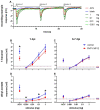Influence of RVFV Infection on Olfactory Perception and Behavior in Drosophila melanogaster
- PMID: 37111444
- PMCID: PMC10142484
- DOI: 10.3390/pathogens12040558
Influence of RVFV Infection on Olfactory Perception and Behavior in Drosophila melanogaster
Abstract
In blood-feeding dipterans, olfaction plays a role in finding hosts and, hence, in spreading pathogens. Several pathogens are known to alter olfactory responses and behavior in vectors. As a mosquito-borne pathogen, Rift Valley Fever Virus (RVFV) can affect humans and cause great losses in livestock. We test the influence of RVFV infection on sensory perception, olfactory choice behavior and activity on a non-biting insect, Drosophila melanogaster, using electroantennograms (EAG), Y-maze, and locomotor activity monitor. Flies were injected with RVFV MP12 strain. Replication of RVFV and its persistence for at least seven days was confirmed by quantitative reverse transcription-PCR (RT-qPCR). One day post injection, infected flies showed weaker EAG responses towards 1-hexanol, vinegar, and ethyl acetate. In the Y-maze, infected flies showed a significantly lower response for 1-hexanol compared to uninfected flies. At days six or seven post infection, no significant difference between infected and control flies could be found in EAG or Y-maze anymore. Activity of infected flies was reduced at both time points. We found an upregulation of the immune-response gene, nitric oxide synthase, in infected flies. An infection with RVFV is able to transiently reduce olfactory perception and attraction towards food-related odors in Drosophila, while effects on activity and immune effector gene expression persist. A similar effect in blood-feeding insects could affect vector competence in RVFV transmitting dipterans.
Keywords: Rift Valley Fever Virus; arbovirus; electroantennography; neuro-immune-interaction; olfactory choice test.
Conflict of interest statement
The authors declare no conflict of interest. The funders had no role in the design of the study; in the collection, analyses, or interpretation of data; in the writing of the manuscript; or in the decision to publish the results.
Figures






Similar articles
-
Culex flavivirus infection in a Culex pipiens mosquito colony and its effects on vector competence for Rift Valley fever phlebovirus.Parasit Vectors. 2018 May 23;11(1):310. doi: 10.1186/s13071-018-2887-4. Parasit Vectors. 2018. PMID: 29792223 Free PMC article.
-
The NSs Protein Encoded by the Virulent Strain of Rift Valley Fever Virus Targets the Expression of Abl2 and the Actin Cytoskeleton of the Host, Affecting Cell Mobility, Cell Shape, and Cell-Cell Adhesion.J Virol. 2020 Dec 9;95(1):e01768-20. doi: 10.1128/JVI.01768-20. Print 2020 Dec 9. J Virol. 2020. PMID: 33087469 Free PMC article.
-
Reproducing the Rift Valley fever virus mosquito-lamb-mosquito transmission cycle.Sci Rep. 2021 Jan 14;11(1):1477. doi: 10.1038/s41598-020-79267-1. Sci Rep. 2021. PMID: 33446733 Free PMC article.
-
Single-cycle replicable Rift Valley fever virus mutants as safe vaccine candidates.Virus Res. 2016 May 2;216:55-65. doi: 10.1016/j.virusres.2015.05.012. Epub 2015 May 27. Virus Res. 2016. PMID: 26022573 Free PMC article. Review.
-
Rift Valley fever virus: strategies for maintenance, survival and vertical transmission in mosquitoes.J Gen Virol. 2017 May;98(5):875-887. doi: 10.1099/jgv.0.000765. Epub 2017 May 30. J Gen Virol. 2017. PMID: 28555542 Review.
Cited by
-
Pathogen-Mediated Alterations of Insect Chemical Communication: From Pheromones to Behavior.Pathogens. 2023 Nov 14;12(11):1350. doi: 10.3390/pathogens12111350. Pathogens. 2023. PMID: 38003813 Free PMC article. Review.
-
Localization of nitric oxide-producing hemocytes in Aedes and Culex mosquitoes infected with bacteria.Cell Tissue Res. 2024 Mar;395(3):313-326. doi: 10.1007/s00441-024-03862-1. Epub 2024 Jan 19. Cell Tissue Res. 2024. PMID: 38240845 Free PMC article.
References
-
- Daubney R., Hudson J.R. Enzootic Hepatitis or Rift Valley Fever. An Un-described Virus Disease of Sheep, Cattle and Man from East Africa. J. Pathol. Bacteriol. 1931;34:545–579. doi: 10.1002/path.1700340418. - DOI
Grants and funding
LinkOut - more resources
Full Text Sources
Molecular Biology Databases
Research Materials

